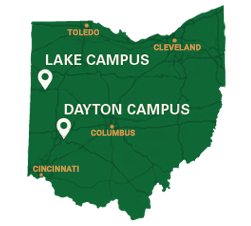Emergency Information
Medical Emergencies
Including chemical exposures:
Go to the Emergency Room or Hospital
circle-arrow-right Report any accident, incident, or near-miss
- Emergency Procedures
- Exposure to Bloodborne Pathogens
- Injuries, Accidents, Illnesses, and Near-Misses
- Hazardous Materials Spill Response
- Work-Related Non-Emergency
triangle-exclamation Emergency Procedures—In Case of Emergency Call
Dayton Campus Public Safety
- From University Phone: 911
- From Cell Phone: 937-775-2111
- Yellow Emergency Phones in buildings
- Blue Light Talk Buttons
- Emergency Action Plan for Dayton Campus.
Lake Campus Emergency Response
- From University Phone: 911
- From Cell Phone: 419-586-7724
- Blue Light Talk Buttons
- Emergency Action Plan for Lake Campus.
All Other Locations
Dial 911 to call local emergency response
Environmental Health and Safety
937-775-2215
For EHS Non-Emergency Service Requests:
Complete the circle-arrow-right EHS Service Form.
biohazard Exposure to Bloodborne Pathogens
Exposure and Spill Response
Immediate confidential medical evaluation and follow-up are available for workers who have an exposure incident, such as a needlestick. Be sure to seek medical assistance as soon as possible.
Emergency Information: Stuck or Splashed?
Immediate Action Required:
- Wash needlesticks and cuts with soap and water.
- Flush splashes to the nose, mouth, or skin with water.
- Irrigate eyes with clean water, saline, or sterile irrigants for 15 minutes.
- Report the incident to your supervisor.
- Seek medical treatment as soon as possible.
Bloodborne Pathogen Contact Information
24-Hour Help
Wright State Physicians Student Health
Contact Information for Immediate Help
937-245-7200
Say "I need the Wright State I.D. doctor."
I.D. means infectious disease
kit-medical Injuries, Accidents, Illnesses, and Near-Misses
The EHS Incident Report Form must be completed for all accidents, incidents, illnesses, and near-misses (including COVID-19).
Filing an Incident Report Form
The EHS Incident Report Form is used for internal purposes. It documents that an injury/incident had occurred and the response is taken. This is used by university employees, visitors, and students alike.
Who: Any individual on university-owned/leased property or during a university-sponsored activity
What: All incidents, injuries, accidents, illnesses, and near-misses
When: As soon as possible after the incident
Why: To prevent future incidents and document as required by law
circle-arrow-right Injuries, Accidents, Illness, and Near-Miss Form
circle-arrow-right Needlesticks or Sharps Injuries Form (PDF)
fill-drip Hazardous Material Spills
Hazardous materials include chemical materials, biological agents, and radioactive materials.
All hazardous materials spills must be reported to EHS as soon as possible. The university is legally required to report certain spills to the Environmental Protection Agency within twenty-four (24) hours of the spill. In order for the university to comply with this requirement, you must immediately report any spill of hazardous material over one (1) pound to EHS at 937-775-2215. There can be legal consequences for a person who spills a Reportable Quantity of hazardous material and fails to report it.
Emergency!
- Immediately activate the nearest fire alarm and evacuate the building.
- Call Public Safety at 937-775-2111 or 911
Immediate actions to take in the event of a spill:
CALL Public SAFETY (937-775-2111 or 911) IF THE SPILL IS:
- Greater than 1 gallon of liquid or 1 lb. or (2.5 kg) of solid material
- Very toxic material
- Poses a fire hazard
- Highly dangerous chemical
- Biohazard agent
- Radioactive material
- If you need assistance with cleanup
PROVIDE DETAILS OF THE ACCIDENT INCLUDING:
- location
- class of hazardous materials involved
- size of spill
- description of any personal injury
- control measures already taken
- your name and phone number
- how you can be identified when emergency personnel arrive at the scene
If the accident involves personal injury or chemical contamination, follow the above steps as appropriate, and at the same time:
- Move the victim from the immediate area of fire, explosion, or spill (if this can be done without further injury to the victim or you).
- Locate nearest emergency eyewash or safety shower.
- Remove any contaminated clothing from the victim and flush all areas of the body contacted by chemicals with copious amounts of water for 15 minutes.
- Administer first aid as appropriate and seek medical attention.
Minor Chemical Spill
In the event of a spill involving the release of a chemical that does not pose an immediate risk to health and does not involve chemical contamination to the body:
- Notify lab personnel and neighbors of the accident
- Isolate the area, close doors, and evacuate the immediate area if necessary
- Remove ignition sources and unplug nearby electrical equipment
- Establish exhaust ventilation, if possible, by turning on fume hoods
- Review the SDS and contact EHS
- Locate the spill kit
- Choose and don appropriate personal protective equipment (goggles, face shield, impervious gloves, lab coat, apron, etc.)
- Clean up according to SDS
- Dispose of materials as directed by EHS
Prepare and Train
All laboratories should have the following supplies:
- A written laboratory-specific emergency plan
- Documented Standard Operating Procedures (SOPs) or protocols
- Documented training in spill response for all laboratory personnel
- A Spill Kit with items to clean and/or contain a biological spill. At a minimum, the spill kit should contain:
- gloves (appropriately sized and within expiration date)
- eye protection
- lab coat (clothing protection)
- paper towels or another appropriate absorbent
- fresh 10% bleach and water solution or other approved sterilization product
- red biohazard bags
- sharps containers
- Broken glass receptacles should also be available.
If you need assistance or have questions, please complete the circle-arrow-right EHS Service Form.
clipboard Work-Related Non-Emergency
Employees and Student Employees
- Notify your supervisor
- Search Bureau of Workers' Compensation certified provider visit:.
- Dayton Campus:
- Closest Urgent Care: GMH Urgent Care
3371 Kemp Rd.
Beavercreek, Ohio 45431
937-458-4200
- Closest Urgent Care: GMH Urgent Care
- Lake Campus:
- Closest Urgent Care: Mercer Health Doctors' Urgent Care
950 S Main St
Celina, Ohio 45822
419-586-7940
- Closest Urgent Care: Mercer Health Doctors' Urgent Care
- Dayton Campus:
- circle-arrow-right Report any accident, incident, or near-miss
Students
- Notify your supervisor
- Search Bureau of Workers' Compensation certified provider visit:
- Dayton Campus:
- Closest Urgent Care: GMH Urgent Care
3371 Kemp Rd.
Beavercreek, Ohio 45431
937-458-4200
- Closest Urgent Care: GMH Urgent Care
- Lake Campus:
- Closest Urgent Care: Mercer Health Doctors' Urgent Care
950 S Main St
Celina, Ohio 45822
419-586-7940
- Closest Urgent Care: Mercer Health Doctors' Urgent Care
- Dayton Campus:
- circle-arrow-right Report any accident, incident, or near-miss
All other individuals, including visitors and contractors
- Seek appropriate treatment at the nearest medical facility
- circle-arrow-right Report any accident, incident, or near-miss

